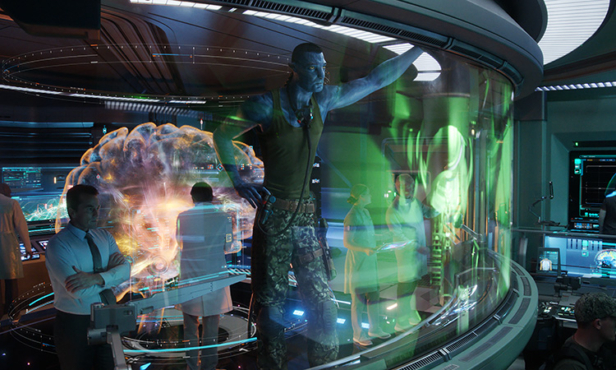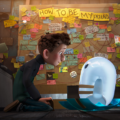Thirteen years is a long time. In 2009, James Cameron’s off-Earth sci-fi epic Avatar was busting blocks all over the globe, had everyone briefly imagining that 3D was the next new (old) thing, and built the all-encompassing lunar world of Pandora out of materials from Soldier Blue (1970), Fantastic Planet (1973), Dances With Wolves (1990), prog rock album covers and even The Smurfs.
Yet for all its aerial spectacles and bioluminescent awe, Avatar also had a surprisingly brief half-life in the collective consciousness, perhaps because the blandness of its characters and the very derivativeness of its ideas made it all too easy for the memory to confuse with so many other, similar things. Still, its box-office takings were as off the planet as its CG locations, ensuring that Cameron’s desire for an extensive franchise would prove equally irresistible to the studios – even if Cameron’s crew would then spend several years developing a system that would allow him to shoot actors’ motion-capture data underwater.
In fact Avatar: The Way of Water is set more than 13 years after the events of the original film. Now permanently residing in an alien Na’vi body, Corporal Jake Sully (Sam Worthington) and his Na’vi wife Neytiri (Zoe Saldaña) have three ‘half-breed’ children of their own – oldest son Neteyam (Jamie Flatters), second son Lo’ak (Britain Dalton) and young daughter Tuktirey (Trinity Jo-li Bliss). They have also more or less adopted two other children: the human teenager Miles “Spider” Soccorro (Jack Champion) who, left behind on Pandora as a baby, went native and now hangs out constantly with the other children; and the adopted Na’vi Kiri (Sigourney Weaver), mysteriously born of a bioengineered Na’vi body in a flotation tank that was formerly the avatar of human scientist Dr Grace Augustine (also Weaver), killed in the first film.
There are other changes. For a new human outpost is being built, no longer seeking to mine Unobtainium for Earth, but to prepare Pandora for mass human colonisation (and to ‘tame’ the natives) – even as a different, even more valuable organic commodity is pursued by a private consortium of seafaring hunters. And much as Sigourney Weaver’s character had been partially resurrected via an irrational genetic legacy, Colonel Miles Quaritch (Stephen Lang) and his fellow Marines, all killed at the end of the first Avatar, have had digital copies of their memories uploaded into Na’vi Recombinants, so that they now return in the bigger, stronger bodies of the aliens that they so despise, wreaking even further havoc on a sentient ecology that has now been tricked into thinking that they are part of it.
Now being hunted, the Sullies leave their jungle home and become refugees with a tribe on the coast, where they must adapt to their new marine environment, integrate into a group that harbours some prejudices against them, and decide whether merely to hide and survive or to stand together as a family against Quaritch.
Even as it plays with the nuances of difference – the grades of involvement and alienation – between humans, mechas, Na’vi, avatars, half-breeds and Recombinants, Avatar: The Way Of Water draws us into its Na’vi world of liminal shorelines and breathtaking reefscapes while questioning whether our 3D immersion in these spaces is initiating us into local lore, or just making us colonisers desiring for ourselves what the Na’vi have. For while Cameron does present us models of humans integrated, to varying degrees, in the Na’vi way of life, he also, time and time again, shows human incursions as egotistical, exploitative, imperialist and destructive of the environment.
The seductive stereoscopy and grand vistas may entice us to get closer to all the beauty, and to become part of this delicate ecosystem whose denizens live at one with nature, yet the story keeps reminding us of what happens when humans intrude. “Venal tourist” is the motto seen written on the T-shirt of marine biologist Dr Ian Garvin (Jemaine Clement) – and that also describes us viewers of Cameron’s film, taken on a paid guided tour through this mysterious world. Without question in this film, our own species, though accommodated in various ways by Pandora, is the real, constant enemy and threat.
Little surprise, then, that as Cameron documents the military-industrial holocaust wrought by ‘Sky People’ against Pandora – the jungles engulfed in walls of flame, the torching of villages with flame throwers, the brutal abuse and objectification of locals (who rise up in guerrilla warfare) – he keeps evoking the imagery of both the Vietnam War in general and of Francis Ford Coppola’s Apocalypse Now (1979) in particular, once again interrogating the moral rectitude of ‘our’ side in an asymmetric colonialist conflict. There are also undersea riffs on George Lucas’ Star Wars: Episode 1 – The Phantom Menace (1999) and Kevin Reynolds’ Waterworld (1995), as well as references to the body-enhancing mechas and sinking vessels of Cameron’s own Aliens (1986) and Titanic (1997).
More surprising, however, is the influence of Herman Melville’s novel Moby Dick; or, The Whale (1851), whose episodes and themes are here amplified and inverted. For where the first film was set in verdant forest, here, as the sequel’s subtitle suggests, the action takes to the water, and we are treated to a whole new range of aqueous flora and fauna, including majestic cetaceous creatures. Yet like the injured whale-like leviathan with which Lo’ak bonds, Avatar: The Way of Water is outsized, bloated and sometimes bumbling, hobbled under its own weight and its unbalanced parts. For in over three hours of family saga, fantasy travelogue, adolescent rite of passage, manhunt and war film, although the visual depth of field and the deep-water locations are striking, the characters remain shallow – more archetype and CG avatar than flesh-and-blood person. In a sense, it can be no other way: for no matter how advanced their digital realisation, these personae will always be straddling an uncanny valley between self and otherness, technology and nature. They enact and embody the film’s central themes – even as we viewers simultaneously take pleasure in the ethnological and biological ideals of this lunar utopia while revelling in the spectacle of its destruction, so that, like the characters, we become divided in our allegiances from our own selves, making the film’s conflicts resonate internally.
The Sully family and their Marine nemeses are all caught in a clash of cultures, identities and ideologies that seems endless, or at least infinitely extendible to a succession of overdrawn features restricted only by how long we are willing to continue paying to be vicarious tourists of Pandora. Here, as with Titanic, Cameron is testing the waters of our bladders’ tolerance as he teases us at undue length with – precisely – images of sloshing, all-enveloping liquids. Cameron has gone on record saying that viewers should feel free to leave at any point for a pee – but this admission that none of his film’s scenes is essential seems less a revolutionary new approach to film narrative as an abandonment of tight story editing.
There are some dynamic set-pieces, dizzying action sequences and panicky thrills – but then there is all the ethnological and biological material, like a fanciful issue of National Geographic brought to life in very slow motion (an impression not helped by James Horner’s ‘world music’ score). The balance between these filmic elements is as fragile as Pandora’s ecosystem – and there are many moments, even longueurs, where this balance is in danger of tipping the wrong way. Avatar: The Way of Water feels long – a sprawling, indulgent trawl through an invented ecosphere that may mirror concerns of our own planet, but also both explores and exposes the limits of wonder.
Avatar: The Way Of Water will be released in cinemas on 16 December



